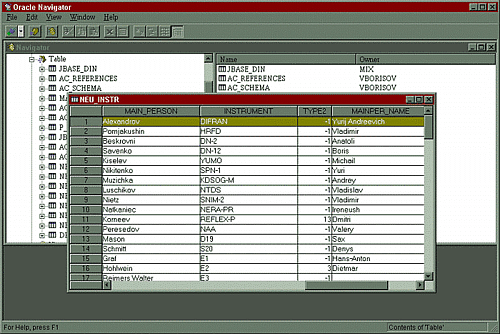The hypertext information system on pulsed neutron sources and scientific investigations based on these sources
E.I. Litvinenko, E.P. Akishina, Y.A. Astakhov,
R.N.Semenov, and I.S. Smolkov
Joint Institute for Nuclear Research,
Frank Laboratory of Neutron Physics
Abstract.
The work on the creation of the hypertext information system has been performed on the basis of the web-server of Frank Laboratory of Neutron Physics of the Joint Institute for Nuclear Research. The work was granted by Russian Foundation of Basic Research in 1996-1997 (grant number 96-07-89189) and was initiated by the project on the creation and maintenance of the hypertext information system on pulsed neutron sources and scientific investigations based on these sources.The initial project proposed the creation of HTML information resources and did not consider the usage of any database for the information management. During the project implementation it became obvious that the system should have well defined structured informational model and it might be helpful to imply the relational database as a part of the system. The ORACLE server in LCTA of JINR has been used for this task. Now we have a set of ORACLE tables designed using CASE tools for the informational model of the system, structured information about neutron sources, neutron instruments, printed publications and URL addresses. We have also the web interface to these tables using freeware gateway ORALINK installed on our Pentium PC with Windows NT and some tools to administer database and view pictures stored in the tables. We took into account NeXuS specifications while tried to design the informational model of the system, and we continue to work on its creation.
Introduction.
The web-sites of the neutron centers are well known and have the references to each other. But in case you search for something related to many of these centers you have no other way than just use global search engines. As a rezult you will spend a lot of time and result is not guaranteed.The project [1] directed on creation the hypertext infosystem for use in the Internet environment has got support from Russian Foundation of Basic Research in 1996. The proposed system should include the HTML [2] information resources about parameters of the most pulsed neutron sources, about neutron instruments and the results of investigations. The proposed system would allow to find quickly the information important for neutron scientists and related specialists.
During the work on the project the decision to apply a database for information management has been made. Fortunately in that time it became possible to get an access to the Oracle server in JINR dedicated for the creation scientific databases. This server was installed in the Laboratory of Computing Techniques and Automation [2] of the JINR according to the large RFBR supported project BAFIZ-96 [3,4]. The goal of the BAFIZ project is the creation a distributed network of knowledge bases on fundamental matter properties and applied nuclear physics available through the web and relational databases in the project-participating institutes.
The work on the hypertext infosystem [5] is performing as an addition to the scientific plans of the laboratory, financing support is made by RFBR only, and people participating in the project are mainly the students and temporarily joined specialists.
The system components.
At the moment the system consists of the relational database tables which include values of different parameters of neutron sources and neutron instruments as well as hyperlinks to HTML resources located everywhere, interface HTML pages and a set of local HTML resources to be used as additional source of information about the corresponding topics.The possibilities of the JINR Oracle server do not permit to organize advanced full-text database because of luck of Oracle Text Server. That is why we decided to store into database tables mainly the numerical and string parameters, hyperlinks and binary data in graphic formats with sources and instruments schematical layouts. We have also some test tables for publications but we have not made final decision about how it is better to store them.
The set of database tables was designed using demo version of Oracle Database Designer - CASE tool by Oracle, free downloaded from their web site. We have a following tables at the moment:
- NEU_SOURCES
- NEU_INSTR
- NEU_INST_TYPE
- NEU_SSCHEMES
- NEU_ISCHEMES
- NEU_PUBL
- Hypertext Infosystem for Pulsed Neutron Sources and Scientific Investigations Based on These Sources, Litvinenko E.I.,
Proceedings of the Intern.Workshop on Advances in Databases and Information Systems (ADBIS'96), Moscow, MEPhI, 1996, pp. 42-46,
http://nfdfn.jinr.ru/~litvin/ADBIS96/ab1/ab1.html - LCTA: http://jicom.jinr.ru/LCTA
- BAFIZ: http://dbserv.jinr.ru/BAFIZ/bfzen.html
- Development of the Networking, Information and Computing Infrastructure at JINR,
R.Pose,V.V.Korenkov,
Proceedings of the Intern. Workshop DANEF 97, Dubna 1997, E10-97-272, pp. 105-115 - HIPNS briefly:
http://nfdfn.jinr.ru/~litvin/infosystem/hipns.html
http://159.93.21.210/~litvin/hipns.html - Window to Oracle SQL Server: http://oradb1.jinr.ru/sql/Window2SQL.htm
- HIPNS gateways:
http://nfdfn.jinr.ru/~litvin/infosystem/hipns_gate.html
http://159.93.21.210/~litvin/hipns_gate.html
http://nfdfn.jinr.dubna.su/~laki/neu.htm - ORALink: http://oradb1.jinr.ru/software/oralink/
- RxLib: http://www.rx.demo.ru
- FLNP: http://ndfdn.jinr.ru
- WebGlimpse: http://glimpse.cs.arizona.edu/webglimpse/
- Http-analyze 1.9e: http://www.netstore.de/Supply/http-analyze/
- NeXus: http://www.neutron.anl.gov/NeXus/
- NeXus: A Proposal for a Common Data Exchange Format for Neutron Scattering Instruments and X-Ray Instruments,
M.Koennecke, P.Klosowski, J.Tishler
Proceedings of the Intern. Workshop DANEF'97, Dubna 1997, E10-97-272, pp. 272-279 - NeXus Instrument Definitions: http://www.neutron.anl.gov/NeXus/NeXus_contents.html#Definitions
-
Main information about neutron sources, including such fields as the name, the institute, the country, the town, the year of start, power, three web links (institute, source, instruments, user applications, proton_current,proton_voltage, frequency, period, target material, comments.
-
The information about neutron instrument, including the name, the type, contact person, e-mail, fax, web link, comment.
-
The list of types of neutron instruments.
-
The schematical layouts of neutron sources.
-
The schematical layouts of neutron instruments
-
Test table with texts of some publications.
There are four ways to have access to these tables: to work with SQL commands on the server machine, to use some client programs on remote PC, for example, trial family of products Personal Oracle (Figure 1), to use specially developed client applications, or to use web interface to the database. The most easy way to administer tables is to use PC client programs with GUIs, but it is possible to send SQL commands from web page as well [6].
 |
| Figure 1. The access with Oracle Navigator provided by Oracle. |
Our common access gateway [7] to the database tables is based on Web-Oracle gateway ORALink [8] which enables WWW administrators to integrate Oracle7 databases with the Web. ORALink was developed as CGI 1.1 compliant script which allows to use it with any CGI 1.1 compliant HTTP server. We have tested it on Windows NT platform with Microsoft Peer Web Server 3.0. HTML forms on interface pages permit user to request database and get results to web browser window.
For the administering database tables the special Delphi 2.0 application have been developed (Figure 2). It provides GUI to view and edit text columns of the tables and visual view on graphic data stored in the tables in GIF format and data files to be stored there. The freeware Delphi component TGIFimage have been used as well as the library of visual components RxLib [8].
The local HTML resources are placed into Frank Laboratory web site [10]. It contains HTML versions of many official FLNP publications, materials of some workshops and equipped with local search engine based on WebGlimpse [11] and statistic control tools [12]. At the moment we are planning to move the site to more powerful computer which we hope to get into the FLNP in the nearest future. At present the performance of our web server on the Sun Sparcstation 2 is not enough sufficient for the amount of everyday requests.
 |
 |
 |
| Figure 2. Administrative access to database tables (Delphi application) |
The informational model aspects.
The informational model of the system was designed taking into account NeXus [13,14] specifications. The information about neutron sources to be included into the relational database consists partially from components of NeXus NXsource class. The definition of the model for neutron instrument is more difficult. At the moment there are about 11 defined types of the instruments for NeXus [15]. All of them we included into our list of types of neutron instruments. But during the consideration of concrete instruments to define the type of them we have found that the list should be extended very much, or divided into more common groups. At the moment we have some temporary decision to have second type for the instrument if needed, but we beleive that the way to define a restricted amount of neutron instruments types should be discussed.
| TYPE_NAME | ID |
|---|---|
| Monochromatic Neutron/X-ray Powder Diffractometer | 1 |
| Time-of-flight Neutron Powder Diffractometer | 2 |
| Monochromatic Neutron/X-ray Single Crystal Diffractometer | 3 |
| Time-of-flight Neutron Single Crystal Diffractometer | 4 |
| Monochromatic Neutron/X-ray Small Angle Scattering Diffractometer | 5 |
| Time-of-flight Neutron Small Angle Scattering Diffractometer | 6 |
| Monochromatic Neutron/X-ray Reflectometer | 7 |
| Time-of-flight Neutron Reflectometer | 8 |
| Neutron/X-ray Triple-Axis Spectrometer | 9 |
| Neutron Direct-Geometry Time-of-flight Spectrometer | 10 |
| Neutron Inverse-Geometry Time-of-flight Spectrometer | 11 |
| Time-of-flight Polarized Neutron Spectrometer | 13 |
| Monochromatic Polarized Neutron Spectrometer | 12 |
| Time-of-flight Inelastic Invert Geometry Spectrometer (?) | 14 |
| Time-of-flight Inelastic Direct Geometry Spectrometer (?) | 15 |
| Monohromatic Inelastic Invert Geometry Spectrometer (?) | 16 |
| Monohromatic Inelastic Direct Geometry Spectrometer (?) | 17 |
For example, E2 and E4 neutron instruments at HMI have two types: Monochromatic Neutron/X-ray Powder Diffractometer and Monochromatic Neutron/X-ray Single Crystal Diffractometer.
We tried to design the database tables as simple as possible. We can increase amount of tables attributes if necessary. To get a more convenient web interfaces we used predefined views on the tables stored into database.
At the moment the main sources of the information are the WWW resources and some printed publications, and we would be very glad to have other ones, especially provided officially.
Conclusion.
The work is in progress. We hope to discuss some informational aspects with NeXus group and will appreciate any interest and comments.Acknowledgments.
We are very appreciated to Dr.V.V.Korenkov and Dr.V.P.Shirikov for the allowance to work on Oracle server machine, to M.S.Plyashkevich for his help as database administrator, Dr.V.I.Prikhodko and G.A.Sukhomlinov for the help.References.

